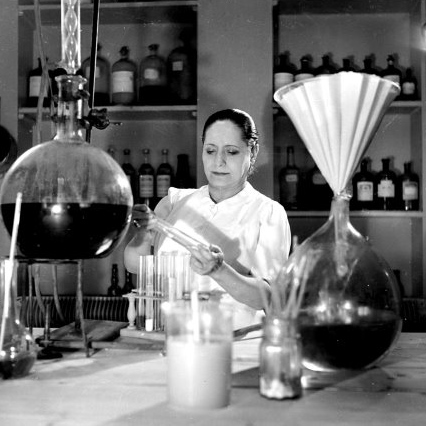click to dowload our latest edition
CLICK HERE TO SUBSCRIBE TO OUR NEWSLETTER


Published
5 years agoon
By
adminJORDAN MOSHE
Rubinstein raised the image of cosmetics from an accessory associated with prostitutes to a desired luxury item that every woman wanted.
When she died at the age of 92, she left behind an international cosmetics business worth millions, as well as a legacy which proves the power of the determined Jewish woman.
Rubinstein, the unofficial queen of the modern cosmetics industry, invented waterproof mascara, and the first moisturising treatment. She also designed the red lipstick worn by the suffragettes as a sign of resistance.
Born Chaya Rubinstein in 1872 to a poor Jewish family in Kraków, she was the eldest of eight daughters born to a strict wholesale food broker and an imposingly beautiful mother.
Mama Augusta Rubinstein would have a tremendous impact on her daughters, especially Helena, insisting they would gain power and influence through beauty and love. She advised them, “If you want to be really clever, listen well, and talk little.”
Rubinstein played an active role in her father’s business, helping him with bookkeeping and taking his place at a business meeting at 15 when he was unwell.
Her dad was determined to see his daughter rise to prominence, and decided that she should study medical science. However, the sights of the hospital sickened her, and when she became thin and unhappy, her father agreed that she could stop her medical studies.
Ever the Jewish father, however, he insisted that she marry, picking out a 35-year-old wealthy widower for his 18-year-old daughter. Rubinstein refused to marry her dad’s choice. Instead, she brought home the man she chose, Stanislaw, a non-Jewish medical student from the University of Kraków.
When papa refused the match, Rubinstein opted to set out for Australia, speaking not a word of English but carrying with her 12 pots of her mother’s beauty cream. These jars of Modjeska cream, named after her mother’s friend, actor Helena Modjeska, would form the foundation of Rubinstein’s fortune, and help her to make a name for herself in the world of cosmetics.
The cream was the creation of Dr Jacob Lykusky, a Hungarian chemist living in Krakow, who used herbs, almonds, and extracts from the bark of the Carpathian fir tree to make it.
For Australian women who suffered from sun-damage, this balm was heaven-sent. Rubinstein dubbed the product Value, which she described as a Hungarian word for “gift from heaven” (although no such word existed). After exhausting the supply provided by her mother, Rubinstein decided to open a shop to sell the cream herself.
She took out a loan of £250 (R4 524) that enabled her to buy a large quantity of the cream from home, and rent and furnish a shop in Melbourne in 1903. She painted the building, and made the curtains and street sign herself, before opening Helena Rubinstein, Beauty Salon for business.
She blazed a trail across the beauty scene in a very short space of time, not only making enough money to bring over Lykusky to develop more products, but experimenting with creams for different kinds of skin in her kitchen. According to her autobiography, the £250 (R4 524) debt became a £12 000 (R217 171) credit by working 18-hour days for two years.
Rubinstein became so successful, she moved to London. There, she opened a beauty salon in Mayfair in the former home of Lord Salisbury. Her clientele was so upmarket, even Margot Asquith, the prime minister’s wife, was a regular patron.
Rubinstein then opened another salon in Paris, and spent a year studying with experts to learn about skin treatment, facial surgery, and good dietary practices.
In 1908, she married an American journalist, Edward William Titus, and had two sons. With the onset of war in Europe in 1914, they moved to New York City in 1915, and opened branches across the United States.
Movie stars like Theda Bara and Pola Negri consulted Rubinstein frequently, learning how to apply mascara, thereby cementing their image as iconic Hollywood vamps for decades to come.
Rubinstein’s luxury salons became destinations for affluent women who were proud to be seen spending hours undergoing treatment, paying enormous sums for the services she provided.
When her husband announced his intention to leave her for another woman in 1928, Rubinstein hastily sold her American business to Lehman Brothers for $7.3 million (R108 million). She hoped this would prove to him that she remained loyal, but it made little difference, and they divorced in 1937.
With the stock market crash, Rubinstein bought back her business for only $1.5 million (R22.3 million), but her personal life improved little. She remained devoted to her work, however, and constantly expanded her empire. She opened the House of Gabrielle for men in a daringly innovative move that proved ahead of its time. She also married a Georgian named Prince Artchil Gourielli-Tchkonia in 1938.
She continued to purvey beauty products during World War II. Although her critics suggested that her products were unnecessary during such hard times, she insisted that women needed the added lift of makeup more than ever. She quoted President Franklin Roosevelt as saying, “Your war effort … is to help keep up the morale of our women. And you are doing it splendidly.”
Rubinstein died in 1965. By that time, her cosmetics business was said to be worth somewhere between $17.5 million and $60 million (R260.3 million and R892.5 million), with international holdings, laboratories, factories, and salons in 14 countries.
